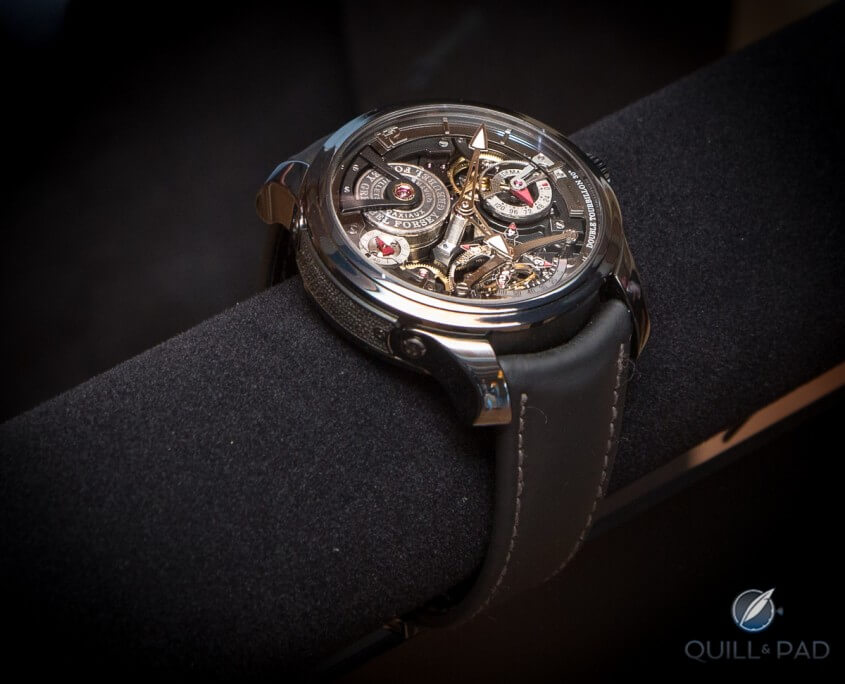Why Accuracy Matters To Me, And Why It Should Matter To You Too
by Ian Skellern
To mark its 50th anniversary in 2009, the International Museum of Horology in Le Locle, Switzerland launched an international chronometry competition. This effectively broke a long drought of 37 years since the last timing trial, which was held by the Observatory of Neuchâtel back in 1972.

Presentation of prizes at the 2013 International Timing Competition
The demise of the trials − and there were quite a few of them − in the late 1960s and early 1970s was due to the seemingly unstoppable dominance of quartz regulators, over mechanical. Quartz blew away its mechanical competition in terms of price, reliability and, whisper it quietly, accuracy.
As the Swiss mechanical watch industry could no longer hope to win even its own prestigious timing competitions, it did what was only natural to anyone familiar with young children: it stopped playing, took its toys out of the sandbox and went home.
Until the 1970s, the vast majority of watches were first and foremost timekeepers, i.e. bought for the express purpose of providing the time. As quartz watches were both cheaper and (generally) more accurate, there didn’t appear to be any way Swiss mechanical watches could compete.
And they couldn’t: two out of every three jobs in the Swiss watchmaking industry disappeared. But in the 1980s the Swiss fought back on two fronts:
1. Swatch took back the lower end of the market with a much simplified movement and great marketing.
2. High-end Swiss brands were reborn as objects exuding “luxury” and “exclusivity” rather than watches to tell the time.
Since then we have seen unparalleled growth in ever more complicated wristwatches, ever more artistic wristwatches and even ever more high-tech mechanical wristwatches.
Despite generally increasing numbers of C.O.S.C.-certified chronometers each year, what we haven’t seen (as yet) is unparalleled growth − or in fact, any growth at all − in more accurate mechanical wristwatches.
Naysayers don’t hesitate to tell us that that is simply how it should be. We can now find the precise time everywhere: in our cars, on our ovens and of course, on our ubiquitous mobile phones. So it’s only natural that wristwatches with mechanical movements have evolved away from being, or aspiring to be, highly accurate timekeepers and toward being pretty strap-on baubles of one-upmanship.
While I do not agree with that line of reasoning, I can at least understand it. However, an argument against accuracy mattering anymore that I find particularly inane is basically the same reason that the international timing trials stopped in the early 1970s, i.e. movements with mechanical regulators cannot compete against quartz regulators, so there is absolutely no point in them competing at all.
Taking that line of reasoning to its logical conclusion would mean that wristwatches will eventually become arm-borne kinetic (or even static) sculptures with no ability to tell the time. Why bother at all when more accurate time is available elsewhere?
And that would imply that the only competition at all worthwhile is that between the world’s fastest, strongest, most accurate, etc. rather than competition between similar classes of athletes or machines.
If mechanical watches shouldn’t compete in accuracy trials because they cannot hope to beat quartz, then should all women’s sporting events be dismissed because they cannot hope to beat men? Are all sporting competitions useless unless between world champions that have a chance of being the absolute best? For that matter, should all sporting competitions based on speed be cancelled because running and swimming fast is now obsolete thanks to more velocious cars, bikes and boats?
Why accuracy matters
Accuracy matters, or to be more precise, matters to me in a mechanical wristwatch because telling the time as precisely as possible is what defines a mechanical wristwatch.
A mechanical wristwatch movement isn’t just a cleverly designed series of gears, springs and bridges going around and around to entertain or provoke the intellect like a miniature Tinguely sculpture: the whole raison d’être of a mechanical movement is to tell the time.
And these days the “time” is an extremely precise measurement known, thanks to atomic and quantum clocks, down to around 19 decimal places: 0.0000000000000000001 of a second. The NPL-CsF2 caesium fountain clock operated by the National Physical Laboratory, which is the U.K.’s primary time reference, is not expected to gain or lose a second in more than 138 million years.
For centuries, horologists have been on a quest for ever better accuracy, and this has led to advancements in materials, techniques, tools, machines and fantastic inventions like the lever escapement, chain-and-fusee constant force, tourbillon and Glucydur balance wheel to name but a few.
They searched for ways to make watches better timekeepers because that’s what a watch is, a keeper of time. Not a keeper of approximate time, but a keeper of time.
I am a big fan of contemporary watchmaking, and I applaud the creativity of many watch brands in terms of design and functionality, but if you are going to call yourself a watch brand, then your watches have to first and foremost tell the time.
For a mechanical watch, telling the precise time is what defines the rules or the playing field in watchmaking. Finish, complexity and design are all things that differentiate between various mechanical watches, but telling the time accurately is what makes them one.
And telling the time well is an endeavor that deserves our admiration and support.
A Ferrari might look fantastic when parked, but the name resonates around the world not because of its beauty, but because it wins races. Does anyone really think that Ferrari shouldn’t compete because planes and speed cameras have made fast cars obsolete?
I feel that it’s a shame that the world’s largest award ceremony for watches, the Grand Prix d’Horlogerie de Genève, offers a Revival Prize for the best contemporary reinterpretation or reissue of an iconic old model, which is basically an award for innovating the least, but nothing to highlight the importance of accuracy.
International Timing Competitions
So I tip my hat to the organizers of the new International Chronometry Competition for making ever better precision a worthwhile endeavor in its own right.
And I salute brands like Jaeger-LeCoultre, who won the first competition in 2009, Greubel Forsey, who won in 2011 (and still holds the record for the most accurate watch), and Tissot in 2013, as well as all of those who entered because competition is never easy: there are always many more also-rans than winners.
But for all of their best efforts, the organizers of the new International Chronometry Competition don’t make it easy to applaud too loudly. Calling it the European Chronometry Competition would be a lot more accurate a description because the competition appears to have been − and in fact has been − deliberately designed to deter non-European competition as much as possible.
But what really holds the competition back is that it is held in total obscurity. To protect the fragile reputations of the brands entering the competition, we are told what watches have entered each year and then a few months later the winners are revealed – nothing else.
What excites people is the competition itself, not the result. Imagine a Formula 1 race in which we see the cars line up on the grid, the starting gun fires, the screen goes blank for two hours and then the winner is announced. That wouldn’t make for good TV and the present format of the International Chronometry Competition doesn’t make for an interesting public event. And to really take off, the trials have to become an interesting public event and I can’t help but worry that they are more likely to become more of an industry platform for benchmarking rather than a true competition.
While both formats – a real international competition that the public cares about or a precision benchmarking service for the industry – are much better than nothing in terms of marking improvement of the precision of mechanical watches, unless the public finds a reason to care about better accuracy then it’s unlikely to amount to much.
What I’d like to see is a move to a more transparent timing competition that the public can follow. That doesn’t have to happen in one go (and scare off the brands from entering), but I would like to see that being the direction that the competition is headed.
And I would like to see brands that have invested considerable time, energy and money into developing materials and mechanisms purportedly to improve accuracy, e.g. Girard-Perregaux’s Constant Escapement and Romain Gauthier’s Logical One, to put their watches to the test.
Aiming for better accuracy in a mechanical watch is something to be recognized and appreciated; however, aiming for something isn’t the same as hitting the target.
To break the rules you have to first master them. That applies to horology as much as it does to improvised jazz and abstract painting. And in terms of watchmaking, that means that a watchmaker should understand how to make an accurate watch before adding artistic embellishments or layers of complications.
Precision isn’t just one of many attributes a watch might have, it is something all watches should have. Aiming for high precision is the noblest aim of all.
*This story was first posted on December 30, 2013.
You may also enjoy:
2015 International Chronometry Competition Now Underway, But Does Anyone Care?
Why The International Chronometry Competition Needs To Change Format Or Sink Into Total Irrelevance
Leave a Reply
Want to join the discussion?Feel free to contribute!




Very good article. Hits the nail in the head. Watch’s purpose is to tell the time. The better it does it, the better it is. Price is irrelevant.
“….because telling the time as precisely as possible is what defines a mechanical wristwatch.”
I wish this were true but it just isn’t.
Remember when “multiplexes” first appeared? (and yes, I did just shudder after typing that). We were told that we would now have improved choice. That we could see loads of different movies which the old two-screen cinemas could not provide. It was nonsense of course. The “choice” which most people seemed to want was to see the most popular three movies of the week at any time they liked, without having to wait more than an hour for a showing to start.
I believe that anyone who finds and engages with this site can reasonably be called “a watch enthusiast”. We want to know the finer points of finishing, dial-work, design, “brand identity” (sigh…), “Heritage” etc. Accuracy is THE LAST thing we talk about. The last thing manufacturers want to discuss or even back up! We get offered watches costing tens or hundreds of thousands of pounds; watches which have their entire identity based on “a stunning new escapement” and the like. They NEVER make accuracy claims. Why is this? The….farce which this article covers shows just how far The Watch Industry is prepared to go to shield itself from the facts. 95% of Swiss wristwatches sold are equipped with at most four relatively basic movement which were designed decades ago. And this is absolutely fine. Any one of these movements can be up-graded and adjusted to provide accuracy which very very few would have a problem with. But if this was admitted, it would destroy the myth of mechanical watch-making and more specifically, SWISS watch-making. Normal people go out to buy a watch with three basic criteria. In order of importance I believe they are
1. Price
2. Brand
3. Style
Accuracy does not even come into it.